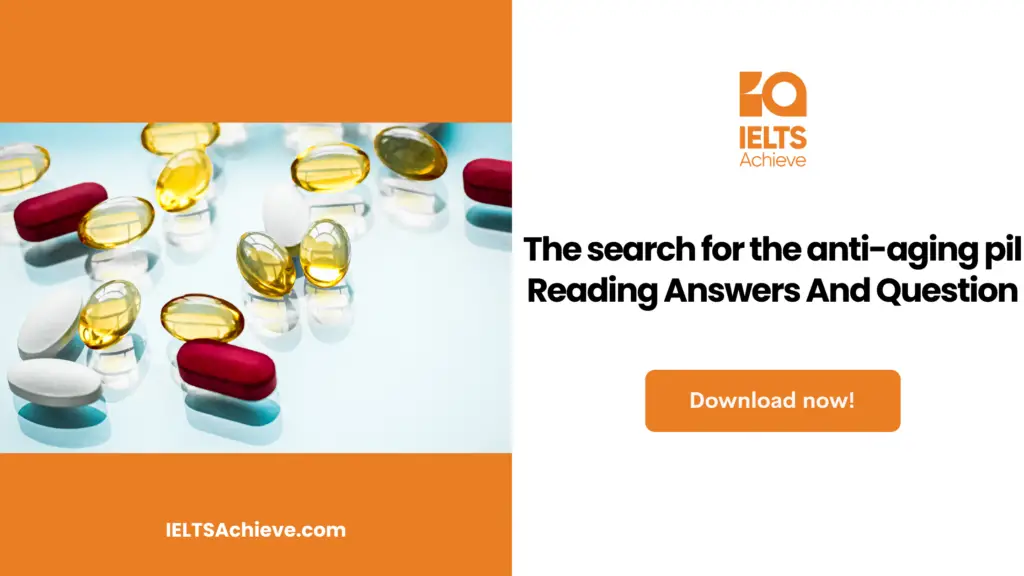The Blog post contains the following IELTS Reading Questions:
- IELTS reading yes no not given
- IELTS reading matching features
- IELTS reading Flowchart completion
Stay informed and prepared for success – Explore our comprehensive Reading Test Info page to get valuable insights, exam format details, and expert tips for mastering the IELTS Reading section.
IELTS Reading Passage: The search for the anti-aging pill

The search for the anti-aging pill
Scientists are searching for a drug that can extend life and restore youthful vitality in government laboratories and other locations. Caloric restriction research is illuminating the path.
No drug currently available has been demonstrated to slow human aging, the accumulation of molecular and cellular damage that increases vulnerability to infirmity as we age, as recently noted by aging researchers. One intervention, however, which increases longevity and maintains good health in a variety of animals, is the consumption of a low-calorie* but nutritionally balanced diet. These results imply that caloric restriction may also increase longevity and postpone aging in humans.
Unfortunately, people would likely need to consume fewer calories—roughly 30% fewer, or 1,750 calories per day instead of 2,500—to get the most benefit. Few mortals could maintain such a strict regimen, especially for so long. What if, however, a drug could be developed that, without actually making people reduce their intake of food, mimicked the physiological effects of doing so? Could this “caloric restriction mimetic,” as we like to call it, help people live longer and healthier lives by delaying the onset of age-related diseases like diabetes, arteriosclerosis, heart disease, and cancer until later in life? After discovering a chemical agent that appeared to replicate many of the advantages of caloric restriction in rodents, scientists first raised this question in the middle of the 1990s. Although a substance that could safely accomplish the same feat in people has not yet been discovered, the search has been fruitful and given rise to optimism that CR mimics may one day be created.
The benefits of caloric restriction
To comprehend the body’s many effects of caloric restriction, researchers began looking for CR mimics. When they discovered that rats fed a low-calorie diet lived on average longer than free-feeding rats and also had a lower incidence of conditions that become more prevalent as people age, scientists first realized the benefits of the practice more than 60 years ago. Additionally, some of the treated animals lived longer than the oldest-living animals in the control group, indicating that not only did the average lifespan increase but also the maximum lifespan (the oldest attainable age). Various interventions, such as infection-fighting medications, can lengthen the average lifespan of a population, but only measures that slow aging will lengthen lifespans to their maximum lifespan.
The rat results have been repeatedly replicated and applied to a wide variety of animals, including yeast, fruit flies, worms, fish, spiders, mice, and hamsters. Studies were previously restricted to short-lived animals that were genetically distinct from humans. However, caloric restriction studies being conducted on the rhesus and squirrel monkeys, two species more closely related to humans, have given scientists hope that CR mimetics may one day benefit humans.
The monkey studies show that calorie-restricted monkeys have lower body temperatures and insulin levels than control animals that eat normally, and they maintain more youthful levels of some hormones that tend to decline with age.
Indicators of risk for age-related diseases also favor caloric-restricted animals. For instance, they have more normal blood glucose levels and lower blood pressure and triglyceride levels, both of which indicate a lower risk for diabetes, which is characterized by abnormally high blood glucose levels. More recently, it has been demonstrated that rhesus monkeys kept on calorie-restricted diets for a prolonged period of time—nearly 15 years—have fewer chronic diseases. However, further observation of them and the other monkeys are required to determine whether low-calorie diets can lengthen monkeys’ average and maximum life spans. CR mimetics would change the fundamental processes that cause aging, in contrast to the numerous elixirs being advertised as the newest anti-aging treatment. Our goal is to create substances that trick cells into turning on maintenance and repair.
How a prototype caloric-restriction mimetic works
The most thoroughly researched candidate for a caloric-restriction mimic, 2DG (2-deoxy-D-glucose), functions by impairing how cells use glucose. It cannot be used on humans because it has been shown to be toxic in animals at some doses. However, it has been shown that certain chemicals can mimic the results of caloric restriction; the challenge is in selecting the right one.
The molecule that fuels numerous bodily processes, ATP (adenosine triphosphate), is produced by cells using the glucose from food. Caloric restriction lowers ATP production and reduces the amount of glucose that enters cells by limiting food intake. When 2DG is given to animals who eat normally, a lot of glucose enters the cells, but the drug prevents the majority of it from being processed, which lowers ATP synthesis. Researchers have put forth a number of theories as to why preventing the production of ATP and processing of glucose might delay aging. One possibility relates to the release of free radicals by the ATP-making machinery, which is thought to speed up aging and age-related diseases like cancer by harming cells. Reduced use of the equipment should keep their output in check and limit the damage. According to another theory, cells may switch into an anti-aging mode that prioritizes the preservation of the organism over such ‘luxuries’ as growth and reproduction if their ability to process glucose is reduced. This would happen even if the food wasn’t actually scarce.
caloric: a measure of the energy value of food
Unlock your full potential in the IELTS Reading section – Visit our IELTS Reading Practice Question Answer page now!
Recommended Questions:
Renewable Energy IELTS Reading Question with Answer
The search for the anti-aging pill IELTS Reading Questions
Questions 1-5
Do the following statements agree with the claims of the writer in Reading Passage? In boxes 1-5 on your answer sheet, write
YES if the statement agrees with the claims of the writer
NO if the statement contradicts the claims of the writer
NOT GIVEN if it is impossible to say what the writer thinks about this
1. A calorie-restricted diet is not likely to appeal to many people.
2. In tests, rats on a high-calorie diet lived longer than those on a free-range diet.
3. Studies indicate that certain drugs on the market today can slow down the aging process.
4. Diseases linked to diet are common in the elderly.
5. Scientific research suggests that consuming fewer calories could lengthen a person’s lifespan.
Want to excel in identifying the writer’s views and claims? Click here to explore our in-depth guide on how to accurately determine Yes, No, or Not Given in the IELTS Reading section.
Questions 6-10
Classify the following descriptions as relating to Write the correct letter, A, B, or C, in boxes 6-10 on your answer sheet.
| A. caloric-restricted monkeys B. control monkeys C. neither caloric-restricted monkeys nor control monkeys |
6. Monkeys had a lower risk of developing heart disease.
7. Insulin was produced in greater amounts in monkeys.
8. There is evidence that monkeys live longer than most other animals.
9. Monkeys had a lower risk of developing diabetes.
10. Chronic illness was more prevalent in monkeys.
Improve your performance in Matching Features questions by clicking here to access our comprehensive guide. Learn how to match specific features or characteristics with the options provided in the IELTS Reading section.
Questions 11-13
Complete the flowchart below.
Choose NO MORE THAN TWO WORDS from the passage for each answer. Write your answers in boxes 11-13 on your answer sheet.
How a caloric-restriction mimetic works
CR mimetic
↓
less 11. ___________ is processed
↓
production of ATP is decreased
↙ ↘
Theory: 1 Theory 2:
cells less damaged by disease because fewer 12. ___are emitted cells focus on 13. ___because food is in short supply
Boost your performance in Summary, Notes, Table, and Flowchart Completion tasks. Click here to explore our detailed guide and learn how to effectively complete summaries, notes, tables, and flowcharts in the IELTS Reading section.
Unlock your full potential in the IELTS Reading section – Visit our IELTS Reading Practice Question Answer page now!
Recommended Questions:
Renewable Energy IELTS Reading Question with Answer
The search for the anti-aging pill Reading Answers
1. Yes
2. Yes
3. No
4. Not given
5. Yes
6. A
7. B
8. C
9. A
10. B
11. Glucose
12. Free radicals
13. Preservation

We hope you found this post useful in helping you to study for the IELTS Test. If you have any questions please let us know in the comments below or on the Facebook page.
The best way to keep up to date with posts like this is to like us on Facebook, then follow us on Instagram and Pinterest. If you need help preparing for the IELTS Test, join the IELTS Achieve Academy and see how we can assist you to achieve your desired band score. We offer an essay correction service, mock exams and online courses.

